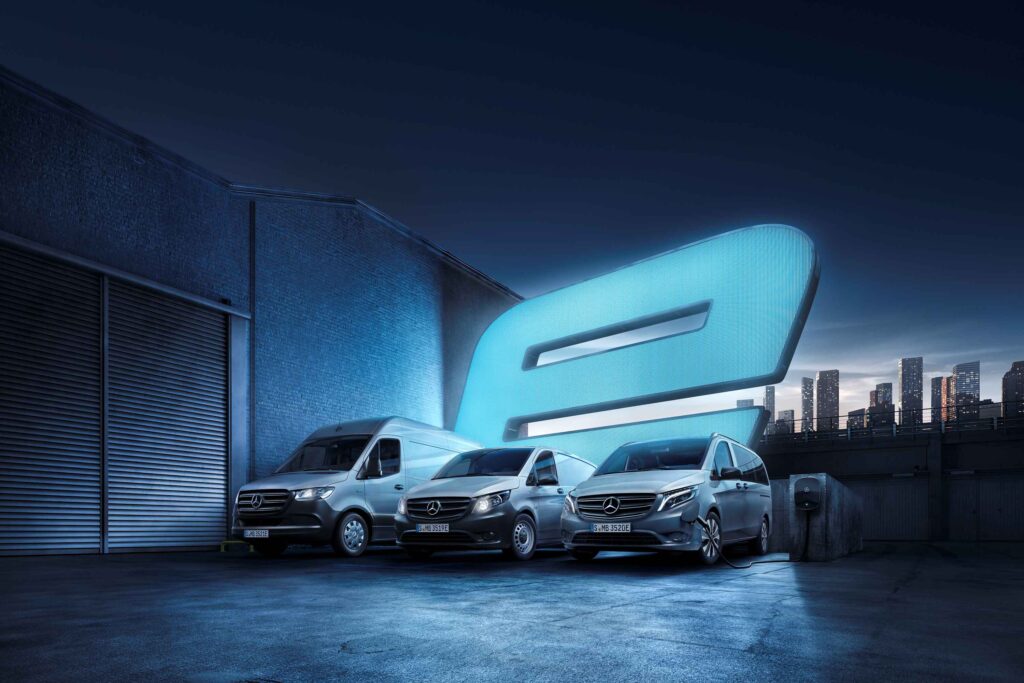Mercedes-Benz Vans Australia is getting ready to offer all of its commercial van model lines with electric drive, and will also add the first fully-electric premium people mover from Mercedes-Benz to the line-up.
This is planned to start in the second half of 2022 with the introduction of the mid-size eVito panel van, eVito Tourer and EQV. The eSprinter is intended to follow in or around 2024 when the next generation eSprinter van becomes available. Thanks to the flexibility of our global vans production strategy, we intend to offer both conventional and battery-electric vans side by side, and are preparing to switch to electric-only in the future, when customer and market demand determines it.
Globally, Mercedes-Benz Vans is systematically driving forward the electrification of its product portfolio with emission-free electric drives, contributing to sustainable mobility in the transport of people and goods. The goal is a holistic electric solution that not only reduces the strain on cities and the environment, but also offers our customers genuine benefits.
In Australia, sales of electric vehicles are on the rise and the electrification of vans is increasingly becoming an attractive proposition for light commercial fleet operators who are looking to show commitment to sustainable practices and reduced total cost of ownership.
Managing Director of Mercedes-Benz Vans, Diane Tarr, said this is a very exciting step towards a more sustainable future for Mercedes-Benz Vans and our customers in Australia. We are confident that the electric drive will gain more prevalence here over the coming years. As it does, we will be ready with a strong customer-centric electric product portfolio, which offers the potential to assist customers with lowering their operating costs and reducing their environmental impact.
Full local specifications and pricing will be communicated closer to launch. However key European technical data for the EQV, and eVito Tourer can be found below. The eVito and next-generation eSprinter technical data relevant for Australia is not yet available.
Technical data of the Mercedes-Benz EQV[1]
|
CO2 emissions |
0 g/km |
|
Range (WLTP combined) |
355 – 356 km |
|
Charging time at a Wallbox or at public charging stations (AC charging, 11 kW) |
<10 h (0-100%)[2] |
|
Charging time at a fast charging station (DC charging, 110 kW) |
10-80 % SOC in <45 min[2] |
|
Drive system |
Front-wheel drive |
|
Output |
150 kW (204 hp) |
|
Peak torque |
362 Nm |
|
Top speed |
160 km/h |
|
Battery |
Lithium-ion |
|
Battery energy content (installed) |
100 kWh |
|
Battery energy capacity |
90 kWh |
|
Length: |
5140 mm[3] |
|
Wheelbase |
3200 mm[3] |
|
Luggage compartment (depending on equipment fitted) |
1030 litres |
|
GVW |
3500 kg |
Technical data of the Mercedes-Benz eVito Tourer[1]
|
CO2 emissions |
0 g/km |
|
Range (WLTP combined) |
360 – 361 km |
|
Charging time at a wallbox or at a public charging station (AC charging, 11 kW) |
<10 h (0-100 %)[2] |
|
Charging time at a rapid charging station: DC charging, 110 kW |
10-80 % in < 45 min[2] |
|
Drive system |
Front-wheel drive |
|
Output (peak) |
150 kW (204 hp) |
|
Output (duration) |
70 kW (95 hp) |
|
Max. torque |
362 Nm |
|
Battery |
Lithium-ion |
|
Battery energy content (usable) |
90 kWh |
|
Energy content of battery |
100 kWh |
|
Length |
5140 mm[3] |
|
Luggage compartment |
1030 litres |
|
Maximum speed |
160 km/h |
|
GVW |
3,500 kg |
[1] Figures stated (including declared range, and torque) are based on European standards [such as Directive No. 2017/1151/EU] and are determined by testing under track and/or standardised laboratory conditions. The figures stated are for the purposes of comparison with other European based figures and amongst vehicles tested under the same technical procedures only. Real world figures (particularly consumption, range and torque) may vary and are influenced by many additional factors such as, vehicle configuration, capabilities of charging infrastructure capacity and/or supply, individual driving style, load, traffic, environmental and road conditions, ambient temperatures and vehicle condition.
[2] Charging times based on a public Direct Current (DC) charging station, charging at a continuous rate of 110kW, from 10% to 80% battery capacity. Charging times can vary depending on many factors including but not limited to ambient conditions, auxiliary consumables (e.g. seat heating and air-conditioning) and capabilities of charging infrastructure capacity and/or supply.
[3] All figures in millimetres. They are indicative figures only based on basic, European specification vehicles and in unladen condition. Actual figures and values may vary and are influenced by many additional factors such as optional equipment. Customers should make additional enquiries based on the specifics of their vehicle to obtain accurate figures.

